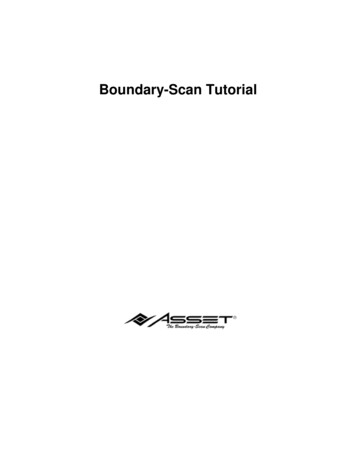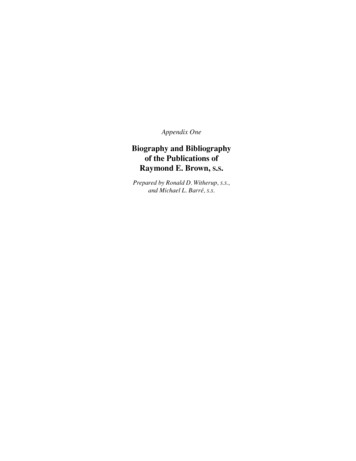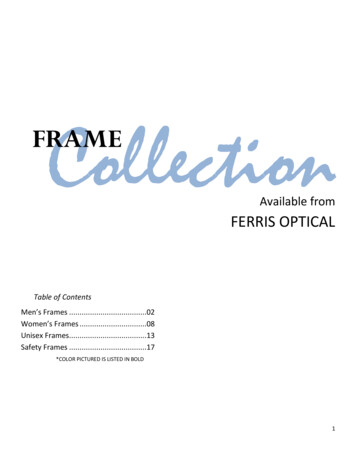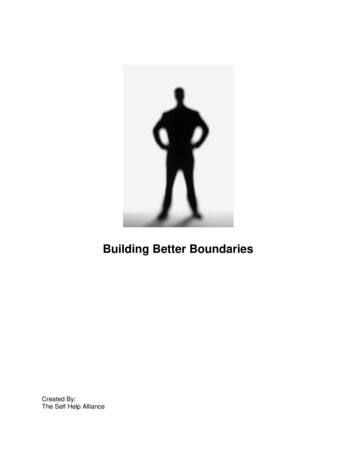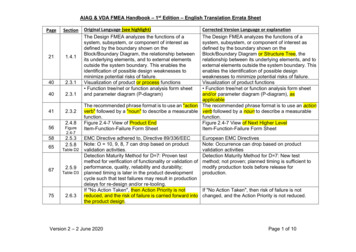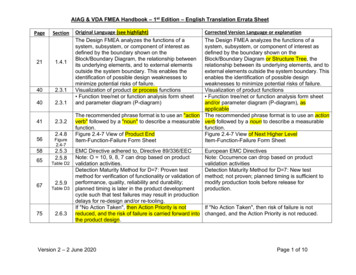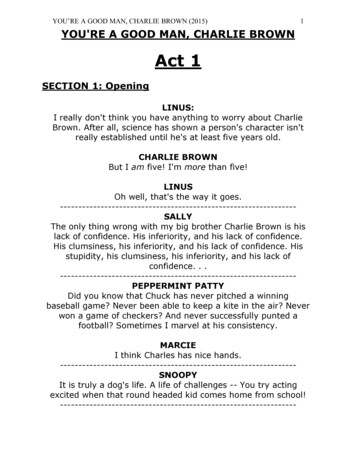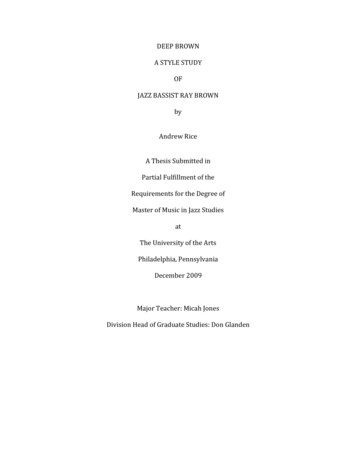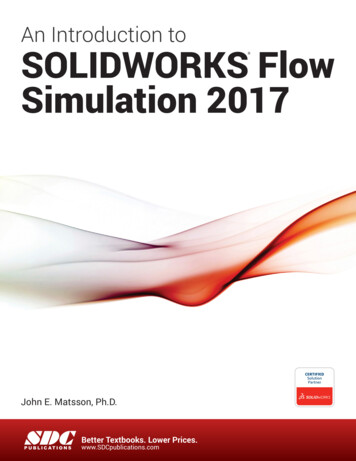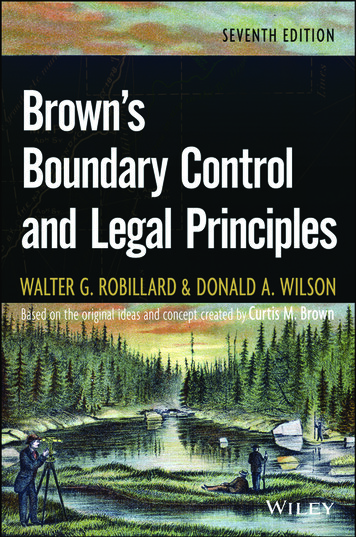
Transcription
BROWN’S BOUNDARY CONTROLAND LEGAL PRINCIPLES
BROWN’S BOUNDARYCONTROL AND LEGALPRINCIPLESSeventh EditionWALTER G. ROBILLARD, B.S., M.A., L.L.M., J.D.Florida, Georgia, North Carolina, and South CarolinaLicensed Land Surveyor; Attorney at LawDONALD A. WILSON, B.S., M.S.Maine and New Hampshire Licensed Land Surveyor;Registered Professional ForesterBased on the Original Ideas and Concept Created byCURTIS M. BROWNChapter 9 contributed by George Cole, PSM, Tallahassee, Florida
Cover Design: Michael RutkowskiCover Image: Verplanck Colvin, Topographical Survey of the Adirondack Region of New York, 1880 /courtesy of the authorThis book is printed on acid-free paper. ⃝Copyright 2014 by John Wiley & Sons, Inc. All rights reservedPublished by John Wiley & Sons, Inc., Hoboken, New JerseyPublished simultaneously in CanadaNo part of this publication may be reproduced, stored in a retrieval system, or transmitted in any formor by any means, electronic, mechanical, photocopying, recording, scanning, or otherwise, except aspermitted under Section 107 or 108 of the 1976 United States Copyright Act, without either the priorwritten permission of the Publisher, or authorization through payment of the appropriate per-copy feeto the Copyright Clearance Center, 222 Rosewood Drive, Danvers, MA 01923, (978) 750-8400, fax(978) 646-8600, or on the web at www.copyright.com. Requests to the Publisher for permission shouldbe addressed to the Permissions Department, John Wiley & Sons, Inc., 111 River Street, Hoboken, NJ07030, (201) 748-6011, fax (201) 748-6008, or online at www.wiley.com/go/permissions.Limit of Liability/Disclaimer of Warranty: While the publisher and author have used their best effortsin preparing this book, they make no representations or warranties with the respect to the accuracyor completeness of the contents of this book and specifically disclaim any implied warranties ofmerchantability or fitness for a particular purpose. No warranty may be created or extended by salesrepresentatives or written sales materials. The advice and strategies contained herein may not besuitable for your situation. You should consult with a professional where appropriate. Neither thepublisher nor the author shall be liable for damages arising herefrom.For general information about our other products and services, please contact ourCustomer Care Department within the United States at (800) 762-2974, outside the United States at(317) 572-3993 or fax (317) 572-4002.Wiley publishes in a variety of print and electronic formats and by print-on-demand. Somematerial included with standard print versions of this book may not be included in e-books or inprint-on-demand. If this book refers to media such as a CD or DVD that is not included in theversion you purchased, you may download this material at http://booksupport.wiley.com. For moreinformation about Wiley products, visit www.wiley.com.Library of Congress Cataloging-in-Publication Data:Robillard, Walter G. (Walter George), 1930–Brown’s boundary control and legal principles / Walter G. Robillard, B.S., M.A., L.L.M., J.D.Florida, Georgia, North Carolina, and South Carolina licensed land surveyor, attorney at law; Donald A.Wilson, B.S., M.S. Maine and New Hampshire licensed land surveyor, registered professional forester ;based on the original ideas and concepts created by Curtis M. Brown. — Seventh edition.pages cmIncludes index.ISBN 978-1-118-43143-6 (cloth), ISBN 978-1-118-75854-0 (ebk.); ISBN 978-1-118-75856-4 (ebk.);ISBN 978-1-118-75078-0 (ebk.)1. Boundaries (Estates)—United States. 2. Surveying—Law and legislation—UnitedStates. 3. Title examinations—United States. I. Wilson, Donald A., 1941– II. Brown, Curtis M.(Curtis Maitland), 1908–1993 Boundary control and legal principles. III. Title. IV. Title: Boundarycontrol and legal principles.KF639.B7 2009346.7304'32—dc232013018924Printed in the United States of America10 9 8 7 6 5 4 3 2 1
CONTENTSPREFACE TO THE SEVENTH EDITIONACKNOWLEDGMENTSCHAPTER 1 HISTORY AND CONCEPT OF BOUNDARIES1.1 Introduction1.2 Significance of Boundaries1.3 Boundary References1.4 Terminus: The God (or Goddess) of Boundaries1.5 Disputes and Boundaries1.6 Role of the Surveyor in Boundaries1.7 What Is Being Created? What Is Being Located?1.8 Original Written Title1.9 Rights and Interests in Land Are Composed of aBundle of Rights1.10 Role of the Court1.11 Real and Personal Property1.12 What Constitutes Real Property1.13 Nature of Modern Estates1.14 Taxes on Land and Tax Maps1.15 Easements and Licenses1.16 Servitudes, Restrictions, Covenants, and Conditions1.17 Actions on Boundaries and Easements1.18 One Unique Parcel or Boundary1.19 The Original Boundaries Are Sacred1.20 132v
viCONTENTSCHAPTER 2 HOW BOUNDARIES ARE CREATED2.1 Introduction2.2 Definitions2.3 Classification of Boundaries2.4 Methods of Boundary Creation2.5 Who May Create Boundaries?2.6 Sanctity of the Original Survey2.7 Original Lines Remain Fixed2.8 Distinctions between the Original Boundary Survey, theRetracement Survey, and the First Survey2.9 Original Technological Methods of Boundary CreationNot Relatable to Modern Methods2.10 Original Lines May Be Redescribed As a Resultof a Retracement2.11 Conclusions353536394043474748495050CHAPTER 3 OWNERSHIP, TRANSFER, AND DESCRIPTION OF REALPROPERTY AND ACCOMPANYING oncepts of Boundaries, Land Ownership,and Land DescriptionsOverview of BoundariesPublic and Private LandsSources of TitleVoluntary Transfer of Real PropertyChain of TitleTorrens Title SystemUnwritten Rights or Title to LandMethods of Voluntary Transfer of TitleDeed or DescriptionTitle or LienDeed of TrustMortgageEscrowTitle Assurance and Title InsuranceAbstractorsAttorney’s OpinionGeneral Land DescriptionsWhat Is in a Description?MeasurementsMagnetic DirectionsReference DatumsElements of Land DescriptionsTypes of DescriptionsConclusionsCHAPTER 4 BOUNDARIES, LAW, AND RELATED PRESUMPTIONS4.14.24.34.4IntroductionConstitutional Law and the SurveyorJurisdictionFederal 6974757777808181828383
CONTENTS4.5 Federal Government, Agency, or Officer as a Party4.6 Sovereign Immunity4.7 United States as a Defendant4.8 Disposing of Federal Lands4.9 Color of Title Act4.10 Public Law 1204.11 Small Tracts Act4.12 Researching the Laws4.13 Court Reports4.14 Legal Research4.15 Judicial Notice4.16 Evidence4.17 Presumptions4.18 Common Presumptions4.19 Survey Systems Present in the United States4.20 ConclusionsCHAPTER 5 CREATION AND INTERPRETATION OF METESAND BOUNDS AND OTHER .215.22IntroductionMethods of Creating Metes and Bounds orNonsectionalized DescriptionsMetes DescriptionsBounds DescriptionsCombination Metes and Bounds DescriptionsStrip Descriptions and StationingDescriptions by ReferenceAliquot DescriptionsOther Means of Creating Boundaries in DescriptionsNomenclature in Metes and Bounds DescriptionsAdjoinersDeed Terms for CurvesLines and Their ElementsTax Descriptions and Abbreviated DescriptionsSubdivision DescriptionsParcels Created by ProtractionFeatures of Platting ActsWriting Land DescriptionsEarly SurveysPriority of Calls in Metes and Bounds SurveysApplying Priority CallsConclusionsCHAPTER 6 CREATION AND RETRACEMENT OF GLOBOUNDARIES6.16.26.36.4IntroductionOriginal Surveys and Corrective SurveysLaw, Manuals, and Special InstructionsEffect of Manuals on 35138139141143143146146147
56.166.176.186.196.206.216.226.236.24History of the Public Land Survey SystemTesting Ground: The Seven RangesAct of May 18, 1796—Clarification of 1785Acts of 18001803—The System ExplodesAct of March 26, 1804Act of February 11, 1805Land Surveys after 1805Survey InstructionsState Instructions and StatutesInstruments UsedField NotesNomenclature for SectionsMeanderingResurveys and RetracementsDefective Boundaries Encountered in ResurveysSectionalized Surveys and InnovationsIrregular Original Government SubdivisionsTownships Other Than RegularSummary of the GLO SystemCHAPTER 7 FEDERAL AND STATE NONSECTIONALIZEDLAND 791811821821821841887.1 Introduction7.2 Early New England and Other Colonial-Era Surveys7.3 Ohio Company of Associates7.4 Donation Tract7.5 Symmes Purchase7.6 Virginia Military District7.7 United States Military Tract7.8 Connecticut Western Reserve and Firelands7.9 Moravian Tracts7.10 Florida Keys Survey7.11 Donation Land Claims7.12 Exchange Surveys and Their Status7.13 Prior Land Grants from Foreign Governments7.14 French Grants in the Louisiana Purchase7.15 Mississippi Townships7.16 Soldier’s Additional Homestead7.17 Indian Allotment Surveys7.18 National Forest Homestead Entry7.19 Tennessee Townships7.20 Florida: Forbes Company Purchase Surveys7.21 Georgia Lot 2203203203203205206Surveys in the Noncontinental United States210General CommentsHawaiian Land LawsPuerto Rican Land Surveys2102102137.227.237.24
357.367.377.387.397.40Federal Mineral Surveys: General CommentsWater and Mineral Right LawsLand Open to Appropriation of MineralsVeins, Lodes, or LedgesExtralateral and Intralimital RightsMill SitesTunnel LocationsSize of ClaimsDiscoveryLocationsPossessionAnnual ExpendituresRequirements for PatentUnited States Mineral SurveyorsSurvey of the ClaimConclusionsCHAPTER 8 LOCATING EASEMENTS AND roductionRights GrantedFee Title or Easement RightThree Easement Descriptions and Three BoundariesOwnership of the Bed of EasementsSurveyor’s Responsibility as to EasementsRequirements for Locating EasementsCenterline PresumptionConveyances with Private Way BoundariesUse of EasementsRevival of Public EasementsCreation of Easement BoundariesDividing Private Street OwnershipWords Used in Centerline ConveyancesApportioning Reversion RightsGeneral Principle of ReversionReversion Rights of a Lot on a Curved StreetLots Adjoining Two Subdivision BoundariesLots at an Angle Point in a RoadIndeterminate SituationsExceptions to the Rules of ApportionmentDescribing Vacated Streets and EasementsLitigating EasementsConclusionsCHAPTER 9 RIPARIAN AND LITTORAL BOUNDARIES9.1 Introduction9.2 Ownership of the Seas9.3 Ownership of the U.S. Territorial Sea9.4 Ownership of Interior Tidal Waters of theUnited 1241242243244245246247248250250252252256256258
169.179.18Landward Boundary of Tidal WatersOwnership of Nontidal Navigable WatersLandward Boundaries of Nontidal WatersSignificance of Public Land Survey Meander LinesOwnership of Non–Publicly Owned Submerged LandsSwamp and Overflowed LandsNavigational ServitudePublic Regulation of Riparian and Littoral LandsShoreline Changes and Water BoundariesApportionment of Riparian and Littoral RightsEmergent or Omitted IslandsWater Boundaries other Than SeaMajor Recognized AreasConclusions and RecommendationsCHAPTER 10 RETRACING AND “RESURVEYING”SECTIONALIZED eas of AuthorityResurvey or RetracementTypes of Surveys and ResurveysCourt of Proper JurisdictionFederal PatentsIntent of the GovernmentSenior RightsFollowing the FootstepsLines Marked and SurveyedOriginal CornersOriginal Field Notes and PlatsClosing CornersIdentification of Corners and LinesMonuments and Their IdentificationEvidence of CornersUse of Testimony in BoundariesCommon UsageUsing Recorded Information to LocateOriginal LinesProportioning: The Last ResortRelocating Lost CornersProportionate Measure or ProrationSingle Proportionate MeasurementDouble Proportionate MeasurementRestoration of Lost Standard Corners on StandardParallels, Correction Lines, and BaselinesRestoration of Lost Township Corners on PrincipalMeridians and Guide MeridiansRestoration of Lost Township and Section Corners OriginallyEstablished with Cross-Ties in Four DirectionsRestoration of Lost Corners along Township 9300301301302303304305306307307308
.4710.4810.4910.5010.5110.5210.53Restoration of Lost Township and Section CornersWhere the Line Was Not Established in One DirectionRestoration of Lost Corners Where the Intersecting LinesHave Been Established in Only Two DirectionsRestoration of Quarter-Section Corners in Regular SectionsRestoration of Quarter-Section Corners WhereOnly Part of a Section Was Surveyed OriginallyRestoration of a Closing Section Corneron a Standard ParallelRestoration of a Lost North Quarter Cornerin a Closing SectionRestoration of Lost Nonriparian Meander CornersRestoration of Riparian Meander LinesRestoration of Nonriparian Meander LinesRestoration of Irregular ExteriorsLost Corner Restoration MethodsResurvey Instructions Issued in 1879 and 1883Half-Mile Posts in Florida and Alabama312313314314315315316317Subdivision of Sections317General CommentsSubdivision by ProtractionEstablishing the North Quarter Corner of ClosingSections on a Standard Parallel and Other QuarterCorners Not Originally SetEstablishment of Centerlines and Center Quarter CornersEstablishment of Quarter-Quarter Section Linesand CornersFractional Sections CenterlineSenior Right of LinesGross Errors and Erroneously Omitted AreasRelocating Corners from Other Townshipsor from Interior CornersProcedures for Conducting RetracementsInterpretation of Aliquot DescriptionsAccording to the Government Measure317318Differences Between State and Federal Interpretations10.54 Applying State Laws10.55 Topography10.56 Boundaries by Area10.57 Establishing Corners10.58 Sections Created under State Jurisdiction10.59 Presumptions and Realities for GLO Surveys10.60 ConclusionsCHAPTER 11 LOCATING SEQUENTIAL CONVEYANCES11.111.211.3xiIntroductionDefinition of Sequential ConveyancesSimultaneous 327329329329330330331332333335337337340341
11.4311.4411.4511.46PossessionSequential PatentsImportance of KnowledgeJunior and Senior Rights between Private PartiesDeeds Must Be in Writing and Deemed to Be WholeDirection of the SurveyTerms of the DeedCall for a PlatInformative and Controlling Terms342342342343344345345346346Order of Importance of Conflicting Title Elements347General CommentsSenior RightsCall for an AdjoinerWritten Intentions of the Parties to the DeedAids to Interpret the Intent of a DeedControl of Unwritten Title LinesLines Marked and SurveyedCorner DefinitionsControl of MonumentsControl between Conflicting MonumentsExplanation of the PrinciplesImportance of the Word “To”Dignity of Record MonumentsControl Point of a MonumentUncalled-For MonumentsError or Mistake in a DescriptionControl of Bearing and DistanceControl of Either Bearing or DistanceDistribution of Errors in Several Boundary LinesCardinal DirectionsUnrestricted General TermsDirection of SurveyArea or SurfacePoint of BeginningConstrued Most Strongly against GrantorErrors and Ambiguous TermsCoordinatesDirect Line MeasurementTreatment of CurvesFirst Stated ConditionsWritten and Character NumbersUnit ImpliedFeet and InchesGeneral and Particular 376376376377Basis of Bearings37811.47 Deflection Method versus Compass Bearings11.48 Summary, Interpretation of the Principles, and Conclusion378381
CONTENTSCHAPTER 12 LOCATING SIMULTANEOUSLY CREATEDBOUNDARIES12.112.2386389Subdivision Boundaries and Corners390Conflicting Elements in Descriptions12.7 General Comments12.8 Original Method of Creating Lots12.9 Intention of the Parties12.10 Finality of Original Lines12.11 Control of Original Monuments withinSubdivision Boundaries12.12 Title Monuments12.13 Control of Monuments Over Plats12.14 Certainty of Monument Identification12.15 Record Description of Monuments12.16 Principles for Presumed Control Between ConflictingMonuments within Subdivisions12.17 Explaining Principles12.18 Introduction to ionDefining Subdivisions12.3 Aliquot Part Subdivision12.4 Controlling Boundaries12.5 Subdivision Macro Boundary Wrongly Monumented12.6 Subdivision Boundaries Incorrectly 94395396398398398399399400404Establishment of Streets405General CommentsEstablishment of Streets by Natural MonumentsEstablishment of Streets and Alleys by Artificial Monumentsand Lines Actually Run at the Time of Making the PlatEstablishment of Streets by ImprovementsEstablishment of Streets by the Line of a Nearby StreetEstablishment of Streets by PlatEstablishment of Streets Where Width Is Not GivenEstablishment of Streets by City Engineers’ Monuments405405Establishment of Lots within Subdivisions412Effect of Mathematical ErrorExcess or DeficiencyProration: A Rule of Last ResortExcess or Deficiency Confined to a BlockExcess or Deficiency Distribution within BlocksSingle Proportionate MeasureSingle Proportionate Measure on CurvesDistribution of Excess and Deficiency Beyond a MonumentEstablishment of Lots Where the End Lot MeasurementIs Not GivenRemnant 0419419
ment of Lots Where No Lot measurement Is GivenEstablishment of Lots with Area Only GivenNew York Rule For Establishment of LotsSummary of Proration RulesEstablishment of Lots Adjoining Subdivision BoundariesEstablishment of Lots Adjoining a Subdivision CorrectlyEstablishedEstablishment of Lots Overlapping the True SubdivisionBoundariesEstablishment of Lots Not Touching the True Boundaryof the SubdivisionProration of Excess and Deficiency in Blocks Closing onSubdivision BoundariesLocating Lots from Boundary LinesObliterated and Lost edings in Partition433General CommentsEstablishment of Lines Determined byProceedings in PartitionEstablishment of Boundaries of Allottees of WillsDeed DivisionsComments433CHAPTER 13 LOCATING COMBINATION DESCRIPTIONS �Of” Descriptions43813.2“Of,” “In,” and “At” Descriptions within Subdivisionsand Adjoining Streets“Of” Descriptions within Metes and Bounds Descriptionsand Adjoining StreetsDirection of MeasurementProportional “Of” ConveyanceException by One-Half by AreaIndeterminate Proportional ConveyancesAngular Direction of the Dividing Line in “Of” DescriptionsAcreage “Of” 449450Overlaps and Gaps454Calls from Two Directions454Establishment of Property Described by Both Metesand Bounds and Subdivision Descriptions454Double DescriptionsNew York Double DescriptionsNatural Phenomena and BoundariesRecognition of Past Events454455455460
CONTENTSCHAPTER 14 ROLE OF THE nFunction of the SurveyorOpinions of Fact and Applications of LawEstablishment of BoundariesEstablishment in Louisiana462464464466467Private Surveys467Responsibility and Authority of the SurveyorBasis of a Boundary SurveyHow Much Research?OwnershipEncroachmentsSearching for MonumentsPossession Marking Original Survey LinesEvidenceSetting 1472472473473474475CHAPTER 15 THE ETHICS AND MORAL RESPONSIBILITIES OFBOUNDARY CREATION AND OF RETRACEMENTS15.1 Introduction15.2 The Philosophy of Boundaries15.3 Applying the Principles to Creating and RetracingBoundaries15.4 Final CommentsGLOSSARY OF TERMSINDEX478478479480486489515
PREFACE TO THE SEVENTH EDITIONIt is amazing how technology in the surveying profession has advanced in the last 50years, as it has in other professions. The medical profession has extended the average human life span, and now we see many octogenarians, some even in our ownfamilies. In contrast, the law, with the exception of a few areas such as human rightsand minority rights, has remained fairly constant. In the field of real property andboundaries, easements, rights of view, and especially air rights, contemporary lawsstill are tied to ancient laws and doctrines. As surveyors struggle to come into themodern world, we now have ready and easy access to modern technology for retracing and re-describing ancient boundaries and rights, some of which were originallycreated decades ago by unknown surveyors who left few records. With this comes aconflict between technology and law, creating for modern courts and surveyors thedilemma of selecting the best course of action.Since this text is used by students as a source for their knowledge of the legalaspects of boundaries as well as by the courts to support their legal decisions concerning boundaries, we hope this new addition will provide the modern guidelinesfor making correct decisions based on sound evidence and proven historic principlesrather than bad decisions based on speculation, guesswork, and poor retracementpractices.Donald A. Wilson, B.S., M.S.,Land Boundary ConsultantPresident, Land & BoundaryConsultants, Inc.Newfields, NHOctober 2013Walter G. (Walt) Robillard, B.S., M.A.,L.L.M., J.D., PLS, RLS, FSMSAttorney At Law, RLS, FSMSAtlanta, GAOctober 2013xvii
ACKNOWLEDGMENTSAppreciation is given to Walt’s grandson Charles A. “Tony” Nettleman III, for hiscontribution to Chapter 9, Riparian and Littoral Boundaries, authored by George Cole.xix
BROWN’S BOUNDARY CONTROLAND LEGAL PRINCIPLES
CHAPTER 1HISTORY AND CONCEPT OFBOUNDARIES1.1INTRODUCTIONThe history and location of boundaries are steeped in the history of the world fromthe time before records were kept to today. These boundaries are a result of actionsof individuals and nations and law. Boundaries can be related to the areas of history,politics, surveying, and law. Both boundaries of an international nature and thosebetween individuals have caused problems that have been fought, are still beingfought, and will continue to be fought in the future over their locations betweennations, states, and individual parcels of land within “Happy Acres” subdivisions.In recent years, both local and international judicial tribunals have had to applyold, proven doctrines and have created new legal doctrines to resolve boundaryissues. One cannot pick up a newspaper or a magazine without reading about someindividual or nation with a boundary issue that is new or that has been festering formany years.Wars have been fought both on an international scale and in local neighborhoods,and people have been killed over boundary disputes of an inconsequential natureinvolving pieces of land that have ranged from hundreds of miles to a fraction ofa foot or meter. Boundaries are personal in nature, and people have been and willcontinue to be protective about the misidentification or misalignment of a known orperceived boundary infringement. The surveyor may become the common factor ina boundary problem, as a result of, for example, preparing an erroneous map showing the boundary between two or more nations or the erroneous depiction of a singleline between two landowners.Even after modern boundary issues have been, seemingly, resolved, membersof both the legal profession and the surveying profession may question the results,1
2HISTORY AND CONCEPT OF BOUNDARIESasking incredulously, “How could the court do that?” Both the trial attorney and thetestifying survey expert could not believe the Court disregarded the case law onthe subject.In the primeval forest, particularly in the plant kingdom, there are no knownboundaries between living things. Although some horticulturists dispute this, weaccept the fact that plants do not create boundaries to separate themselves. Animals—especially humans—do create boundaries. We like to think that only humans createand appreciate boundaries, but it has been observed in nature that most mammals,some reptiles, and a few fish create, identify, mark, and defend boundaries.In this book, we discuss the creation, identification, description, and recoveryof boundaries among people. We do not include the recovery and interpretation ofthe evidence of once-created boundaries; rather, we examine how boundaries arecreated, how they are described, and the technical legal and ethical ramifications ofsuch boundaries that separate rights, both real and perceived, in real property.Some boundaries are created in a random manner, whereas others are created according to preconceived plans, identified by any manner of a writtendescription(s), and then litigated according to common law, case law, or statutelaw.1 Although it is not our intent in this book to dwell on the creation of boundaries by the lower forms of animal life, their actions in creating boundaries should beexamined, because certain principles are similar. Many of these boundaries humanscreate remain for generations and, when they are retraced by modern methods andwith a modern approach, may cause technical and legal problems for today’s surveyors and courts.Field examinations and studies by naturalists have revealed that most animalsreally don’t create boundaries per se. However, it is recognized that they usually create terminal points (corners) and then identify the boundaries between these points,2although lower forms of animals may create boundaries that are not necessarily ofa permanent nature.Humans usually create boundaries in several ways. For the sake of simplicity,these may be placed in the following categories:1. By action. Physical acts create a line and points on the ground. This is followed by placing actual monuments at the corner points and identifying thesepoints (corners) and line objects. The lines and objects are then described andmay be identified on plats or in field notes. This evidence created and left “onthe ground” becomes the proof of the original work and lines and becomes thelegal controlling factor in conducting retracements.2. By writings. The written word becomes the method of creation when a persondescribes corners and/or lines in a deed and then conveys to these describedlines, prior to the completion of a survey. The problem is created whenwhat the surveyor places on the ground is and then fails to create a solidpaper trail.3. By law. Ancient common and modern statutes are relied on to create, modify,and relocate many modern boundaries.
1.2 SIGNIFICANCE OF BOUNDARIES3The following principles are introduced in this chapter and discussed in detail inlater chapters:principle 1. Boundaries enjoy a long history in both mythology and JudaicChristian history.principle 2. A surveyor creates land boundaries. These created lines, which areseparate and distinct from property lines, are determined by legalprinciples and law.principle 3. A described closed boundary identifies a claim of right to anyproperty interest for which any person can make a claim of possession through a claim of title. These boundaries may be eithermacro or micro in nature.principle 4. A person or landowner can legally convey only the quality andquantity of interest in land to which he or she has title.principle 5. In most instances, there are no federal laws describing real property rights.principle 6. Although there are no federal laws of real property, property rightsare identified by the state laws and are protected under the U.S.Constitution.principle 7. Real property rights are determined according to the laws in effectin the particular locale where the land is located. English commonlaw is the predominant law, and it is described as the lex loci.principle 8. Once boundary lines are created, the contiguous lines may, bylaw or by the actions of landowners who have vested rights, bechanged or altered.principle 9. Law does not provide for two original descriptions of the sameparcel.principle 10. Multiple boundary descriptions may exist for the same parcel, butonly one is controlling.principle 11. There can be only one original boundary survey and description;all subsequent ones are retracements.principle 12. A resurvey can be conducted only by the entity who conductedthe original survey. The law provides for resurveys of parcels, butonly on a limited basis and under certain restrictions, the main onebeing that the bona fide property rights granted under the previoussurvey are not jeopardized.1.2 SIGNIFICANCE OF BOUNDARIESThe description of property by surveys and landmarks and by reference to boundaries is very ancient. Basically, property interests are separated by boundaries. Fromprecolonial times in the United States, many wars, both local and regional, have been
4HISTORY AND CONCEPT OF BOUNDARIESfought and people have been killed as a result of disputed boundaries. This problemwas probably inherited from the European continent when the United States adoptedEnglish common law as the basis of its common law.In Great Britain and in Europe, territorial boundaries have, for the most
CHAPTER 2 HOW BOUNDARIES ARE CREATED 35 2.1 Introduction 35 2.2 Definitions 36 2.3 Classification of Boundaries 39 2.4 Methods of Boundary Creation 40 2.5 Who May Create Boundaries? 43 2.6 Sanctity of the Original Survey 47 2.7 Original Lines Remain Fixed 47 2.8 Distinctions between the Original Boundary Survey, the
